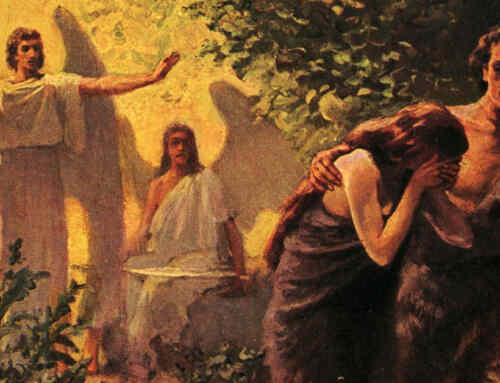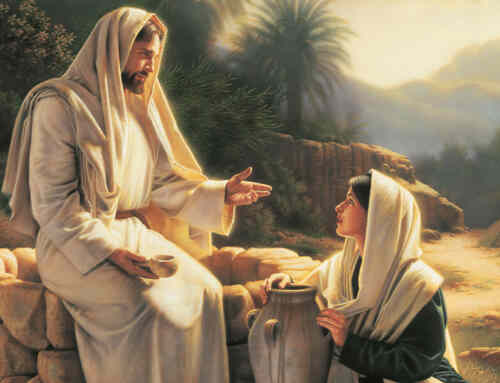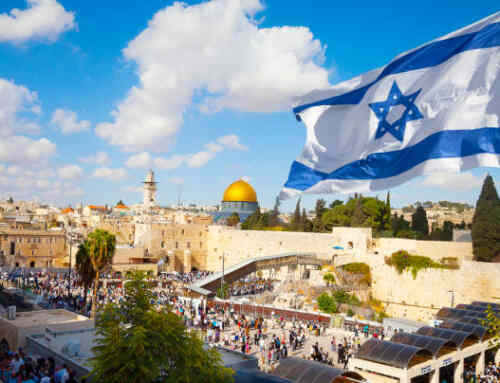Reading the accounts together in Matthew 27:45-51, Mark 15:33-39, Luke 23:46-49 and John 19:25-30, this world-changing event is one of the most dramatic we will ever hear or read.
The first question this scene raises is, why did God send an earthquake? In the Scriptures, an earthquake is used to describe social upheaval. For example, Joel 3:16 uses an earthquake to describe the time when God will fight for Israel in Armageddon against the nations that come against her.
In keeping with this symbolism, causing an earthquake at the moment of Jesus’ death suggests that a great social upheaval was imminent. This was prophetic of events that would take place for the nation that rejected and crucified the Lord. History confirms that Israel’s national identity was lost in AD 70 when Rome destroyed the temple and the city of Jerusalem. God used an earthquake to send this to Israel message upon the death of His son.
The other event that occurred in connection with the earthquake was the opening of the graves. The passage reads, “…The earth did quake, and the rocks rent; and the graves were opened; and many bodies of the saints which slept arose and came out of the graves after his resurrection, and went into the holy city, and appeared unto many” Matthew 27:51-53.
As the previous answer suggests, the meaning of this passage has been questioned. But upon close examination the answer seems evident. The Greek word used when saying these individuals “arose” is the word “egeiro” (Strong’s # 1453).
Though it can be used for waking from natural sleep, its use here is consistent with the three miracles Jesus performed when he raised the dead. It is the same word used for the awakening of Lazarus (John 12:9), the awakening of the widow’s son (Luke 7:14) and the awakening of Jairus’ daughter (Luke 8:54).
Lazarus is described as, “he whom he had raised (egeiro) from the dead.“
To the widows’ son Jesus said, “I say unto thee arise (egeiro).”
To Jairus’ daughter he said, “maid arise (egeiro).”
These were not resurrections in the full sense of the word. They are often referred to as resuscitations, since the individuals eventually died again. These also stands in marked contrast to the resurrection of Jesus who was rewarded with immortality and would never die again. The awakenings Jesus performed, and those described after his death, were intended to prove the authenticity of who Jesus was.
What helps clarify the meaning of this passage is the sequence of events. There are two events described:
- the opening of the tombs caused by an earthquake, and
- the raising of the saints after the resurrection of Jesus. These events are separated by parts of three days. The earthquake occurred when Jesus died. The saints were raised upon his resurrection, three days later.
This timing was intended as a final witness that the resurrection of Jesus would mean life for the world. Many have claimed to be Messiah (See Matthew 13:22; 1 John 4:1), but here was a man whose death shook the earth and whose resurrection brought forth life. The sequence is significant.
By raising these individuals as immediate evidence of Jesus’ own resurrection, it would seem reasonable that they would be known to the citizens of Jerusalem and recognized that they had been dead. Recall how the Chief Priests and Pharisees demanded that Pilate put guards at the tomb of Jesus, lest the disciples steal his body and say that he was raised from the dead.
When Jews living in Jerusalem heard that his body was no longer in the tomb but were told by their religious leaders that his disciples had stolen it, Jesus’ Messianic claims would be ignored, believing he was just another “false prophet.” But if the people of Jerusalem met and spoke with individuals whose funeral they had attended and who may have been dead for some time, all the claims that Jesus was a criminal, worthy of death, were proven wrong.
It was unequivocal proof that Jesus was the true Messiah.
Here is a second interpretation:
The expressions “out of the graves [tombs]” and “out of the tomb” have different shades of meaning in the New Testament,
The expression, “out of the tomb”, is twice used in the singular. John 12:17 (NKJV), “…He called Lazarus out of his tomb and raised him from the dead…” It’s used about Jesus when Mary of Magdala surmised that “they have taken away the Lord out of the tomb.” John 20:2. In each case, it is of someone coming out from inside a specific tomb.
Matthew 8:28 speaks in the plural of two demoniacs “coming forth out of the tombs.” Mark 5:2 speaks similarly of a man with an unclean spirit. Clearly, none of these three was dead; so the expression evidently merely means these were in a cemetery, and not necessarily inside a tomb (empty or not). Luke 8:27 speaks of a demoniac who “abode … in the tombs,” when he also was not dead.
It is also in the plural, later in Matthew 27:52-53 (WEB), “And the graves were opened, and many bodies of saints who slept, arose, and came out of the graves after his resurrection, and went into the holy city, and appeared to many.”
Some questions about this seemingly mysterious account need be resolved:
* Is any group called “saints” other than Jesus Christ and his church?
* At the end of verse 52, the Greek word primarily means “awaken, arouse” (Liddell & Scott). Does it mean awaken from sleep or from death in this context?
* It says, “they came forth … after his resurrection,” not “after their resurrection(s).”
The text may be easier to understand than it seems at first glance. The “saints” need only come out of a cemetery. The “saints” usually means the (faithful) church, so why not the apostles here? They had been so tired after the Last Supper that they could not watch one hour without falling asleep, and it is here said that they had fallen asleep, so the earthquake awakened them. They remained fugitives in the city of Jerusalem until after Jesus was resurrected.
Here is yet a third interpretation:
According to Matthew, when Jesus died, the earthquake split the rocks and bodies arose. This “raising of the saints”, who they were and what they did is a controversial subject. The account indicates they rose up and were visible to many but gives no indication as to what they may have done. If they rose to be witnesses, to whom did they witness? Did they meet with the disciples? The apostles were accused of “filling Jerusalem with their teaching” (Acts 5:28) – it seems likely that if risen saints were spreading the teachings of Christ, there would be some record. It must also be noted that neither the Mark, Luke or John accounts collaborate the earthquake and the opening of graves.
We suggest, instead, that during the earthquake, bodies that had been buried were thrown up and exposed to view. They remained visible until after Christ’s resurrection. ?These corpses would have been seen by many persons in the city. Alternatively, some have suggested that perhaps this is a reference to the Apostles and disciples who were hiding in the cemetery to escape arrest. These men (saints) were the ones aroused from their sleep due to the earthquake. In any case, there was no resurrection of dead saints.
Jesus was the first to be resurrected from the dead. Colossians 1:18 (NASB), “He is also head of the body, the church; and He is the beginning, the firstborn from the dead, so that He Himself will come to have first place in everything.” We know that Jesus was resurrected on the third day from His crucifixion on Sunday. Therefore, no dead could be raised right after Jesus died on that Friday.
Additional Resources:
Christian Questions Podcast
Episode #1276: “When Jesus Said, “It is Finished,” What Did He Begin?”
Absorbing the crucifixion through the eyes of bible prophecy
Preview Video
CQ Rewind Show Notes
Episode #1089: “Why So Many Contradictions Surrounding Jesus’ Resurrection? Contradictions (Part IV)”
Exploring the contradictory gospel records of Jesus’ resurrection
Preview Video
CQ Rewind Show Notes













